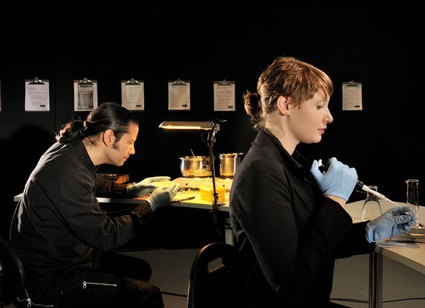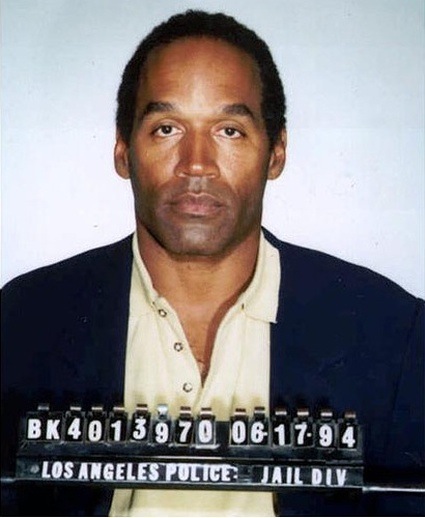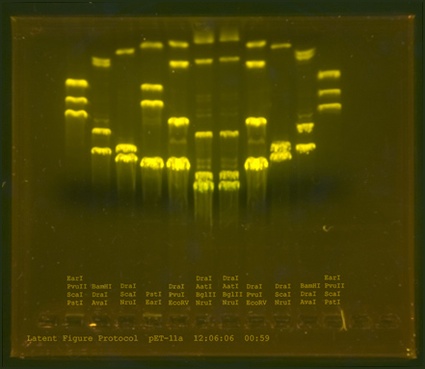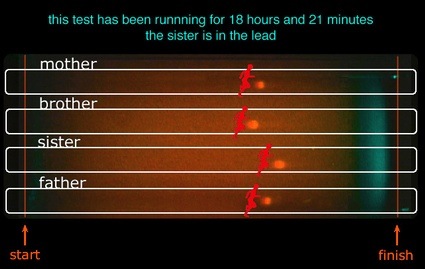 Paul Vanouse and Kerry Sheehan working at the Suspect Inversion Center. Photo: Axel Heise
Paul Vanouse and Kerry Sheehan working at the Suspect Inversion Center. Photo: Axel Heise
While the reliability of ballistic, bite-mark and even fingerprint analysis can sometimes be questioned in courtrooms, genetic evidence is still widely regarded as the forensic gold standard.
Unfortunately, accidents happen. Remember the fiasco of the DNA evidence brought forward at the trial of O. J. Simpson?
 Mug shot of O. J. Simpson
Mug shot of O. J. Simpson
Or the deep embarrassment of European police when they found out that a mysterious serial killer known as the The Woman Without a Face had in fact never existed? The only clues that the criminal had left behind at 40 different crime scenes were DNA traces. These were collected on cotton swabs and supplied to the police in a number of European countries. The police later discovered that the DNA had very probably been left by a woman working for the German medical company supplying the swabs, who had inadvertently contaminated them.
There’s more in the case against the fail-proof quality of DNA evidence. Three years ago, a crime lab analyst found out that DNA “matches” are not always as trustworthy as one might believe. While a person’s genetic makeup is unique, his or her genetic profile — just a tiny sliver of the full genome — may not be. Siblings often share genetic markers at several locations, and even unrelated people can share some by coincidence.
And in Israel, scientists have demonstrated that DNA evidence can be fabricated. “You can just engineer a crime scene,” said Dan Frumkin, lead author of a paper published in 2009. “Any biology undergraduate could perform this.”
Paul Vanouse is doing just that with his latest work, the Suspect Inversion Center. Together with his assistant Kerry Sheehan, the biomedia artist set up an operational laboratory at the Ernst Schering Foundation in Berlin. Using equipment anyone can buy on the internet as well as Vanouse’s own DNA, they (re)create in front of the public identical “genetic fingerprints” of criminals and celebrities.
 Latent Figure Protocol
Latent Figure Protocol
The solo exhibition features two other biological artworks by the American artist: a series of Latent Figure Protocol lightboxes and Relative Velocity Inscription Device, a cynical molecular race reflecting on biologically legitimized racism, in which bits of DNA, instead of bodies, compete by testing their “genetic fitness”. The work uses DNA samples from Vanouse family and directly references Charles Davenport‘s book Race Crossing in Jamaica (1929), which attempted to provide statistical evidence for biological and cultural degradation following interbreeding between white and black populations.
 Relative Velocity Inscription Device (detail of the installation)
Relative Velocity Inscription Device (detail of the installation)
The press release for the exhibition says:
Vanouse’s biotechnological installations do not only challenge the codes and images of contemporary knowledge production but also question the methods behind (natural) scientific findings in general: What do uncritically accepted commonplace catchwords such as “genetic fingerprint” conceal? To what extend does the technical construction of alleged naturalness notarize clichés and prejudices? Vanouse diverts biotechnologies and scientific imaging techniques from their intended uses, and amalgamates auratic iconography with technical images. Employing gel electrophoresis as artistic medium, he intentionally applies a method that bears analogies to photography: while photography allowed viewers to draw seemingly objective conclusions about human qualities based on physiognomic characteristics of the body, today, increasingly questionable social conclusions are derived from ontologized body fragments such as genes.
Curated by Jens Hauser, Paul Vanouse: Fingerprints… remains open at the Ernst Schering Foundation (google map) until March 26, 2011. The foundation, which aims to promote science and art, was showing the wonderful work of Agnes Meyer-Brandis last year: Cloud Core Scanner – an artistic experiment in zero gravity.
More posts featuring the work of Paul Vanouse: Wetware Hackers Day 2 and Hybrid Art awards.
